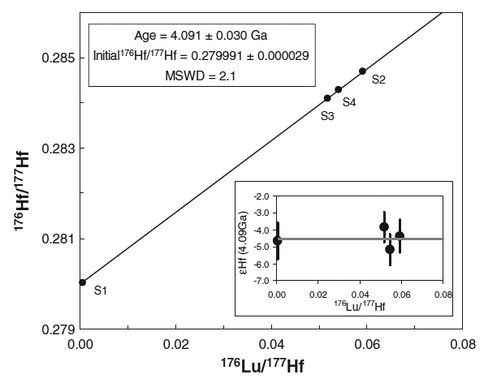2010 Annual Science Report
 University of Wisconsin
Reporting | SEP 2009 – AUG 2010
University of Wisconsin
Reporting | SEP 2009 – AUG 2010
Project 5D: The Rock That Started It All: Geochronology of Mars Meteorite ALH84001
Project Summary
The possible biosignatures that were discovered in Martian meteorite ALHA84001 by McKay et al. (1996) can be significantly credited with establishing the NAI. Despite the importance of this sample in spurring a variety of research efforts to evaluate how one could determine if there was ancient life on other planets, we still do not convincingly know the age of this sample. Original geochronologic work indicated that this sample crystallized soon after planetary accretion at ~4.5 Ga (e.g., Nyquist et al., 2001). We have begun re-evaluating the crystallization age of this meteorite using new geochronologic techniques, and based on these new results the crystallization age for this sample is in need of revision and we suggest that an age of 4.09 Ga is more appropriate (Lapen et al., 2010). This younger age fits much better into generally accepted models for the early evolution of Mars.
Project Progress
Geochronology on Martian meteorites is difficult because of their complicated history that includes crystallization from an igneous melt, Martian weathering processes, impact shock processes associated with ejection into space, space weathering processes and terrestrial alteration. Past work on ALHA84001 has applied very stringent mineral separation methods and geochemical techniques to see through all of the processes that have had an impact on this sample. Traditionally people have thought that the Sm-Nd system should be the most robust geochronometer and thus have used this system to determine the time of igneous crystallization of SNC meteorites. However, the bulk of Sm and Nd in ALHA84001 are in phosphate phases which are susceptible to some open system behavior during low pH Martian weathering processes. We have used the Lu-Hf system to avoid such possible open system behavior because the bulk of Lu and Hf are contained in orthopyroxene and chromite which are phases that would be resistant to open system behavior relative to phosphate in low pH environments. A mineral isochron which includes oxide, pyroxene and bulk rock defines an age of 4.091 ±0.030 Ga (Lapen et al., 2010). Sm-Nd analyses on the same minerals do not define an isochron and appear to be the result of some type of open system behavior likely associate with low pH weathering (Lapen et al., 2010).
Future work is devoted to conducting a Rb-Sr investigation on ultra high purity mineral separates using new analytical techniques that allow us to analyze 87Sr/86Sr ratios to a precision of 0.007% on as little as 500 picograms of Sr (10-12 grams). We anticipate being able to analyze pyroxene, maskelynite (shocked plagioclase glass), and oxide phases that should allow us to see through possible alteration processes.
Figure 1. Lu-Hf isochron age for ALH84001. This age is significantly younger than poorly constrained earlier ages of ~4.5 Ga, determined using the Sm-Nd system. From Lapen et al. (2010).
Publications
-
Lapen, T. J., Righter, M., Brandon, A. D., Debaille, V., Beard, B. L., Shafer, J. T., & Peslier, A. H. (2010). A Younger Age for ALH84001 and Its Geochemical Link to Shergottite Sources in Mars. Science, 328(5976), 347–351. doi:10.1126/science.1185395
- McKay, D.S., Gibson EK, J., Thomas-Keprta, K.L., Clemett, S.J., Chillier, X.D.F., Maechling, C.R. & Zare, R.N. (1996). Search for past life on Mars: Possible relic biogenic activity in Martian meteorite. Science, 273: 924-930.
- Nyquist, L.E., Bogard, D.D., Shih, C-., Greshake, A., Stöffler, D. & Eugster, O. (2001). Ages and geologic histories of martian meteorites. Space Science Reviews, 96: 105-164.
-
PROJECT INVESTIGATORS:
-
PROJECT MEMBERS:
Clark Johnson
Co-Investigator
Tom Lapen
Collaborator
Jim Ludois
Doctoral Student
-
RELATED OBJECTIVES:
Objective 2.1
Mars exploration.
Objective 7.1
Biosignatures to be sought in Solar System materials

